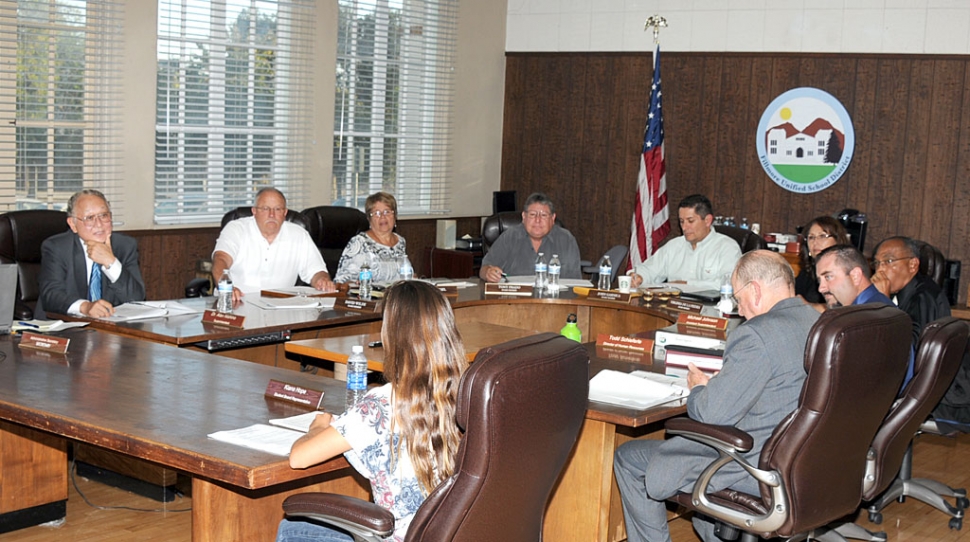|
Fillmore Unified Hires 20 New Teachers
 By Jean McLeod — Wednesday, August 7th, 2013
 Secretary/Executiv Assistant, Irma Mendez  Student Rep/Speaker of the House, Kiana Hope Well it's that time again, when the school bell rings on August 15th and classes begin. Tuesday's Fillmore Unified School District (FUSD) Board meeting was the first of the 2013-2014 school year and with it came some changes. Those changes include 20 new certified staff members and new principals. Fillmore Middle School has hired six new teachers in various subjects: math, physical education, special education, language arts and two in history. Fillmore High School has a new Vice Principal, Joann Dabbs and San Cayetano a new Principal, Trisha Gradies, along with five new teacher; Kelly Sebek 1st grade, Marie Enriquez k-1st, Lucy Sevenson, Alisa Mitchel, Gaby Lopes, Special Education Severally Handicapped. Adding to the lineup is the new Secretary/Executive Assistant Irma Mendez who moved here from San Diego to be part of FUSD staff. Another new face at the board meeting was the new Student Representative/Speaker of the House Kiana Hope, a senior at Fillmore High School. Hope informed the Board that freshman orientation went smoothly but there were less Student Ambassadors to help with the orientation and more freshman students participate this year than had in the past. One of the biggest changes to the district is the opening of the new school, Rio Vista Elementary. The new school begins with 530-550 students and 25 classrooms: three kindergarten, one music, one science and 20 for 1st through 6th grades. About 60 of the new students will have transferred over from Sespe Elementary due to new school boundary lines. The new Principal, Victor Torres, has taught from elementary grades to high school. His resume includes Granada Hills High School along with working in Palmdale at a turn around school as an assistant principal and today is also a board member at Castaic Unified School District. The School Budget is not as healthy as once believed stated Assistant Superintendent Earl Davis and is still a work in progress. Davis informed the Board of the difference in funding from what Governor Brown had originally proposed saying the bill..."went through a rush with 25 transitional bills that followed....like peeling an onion, what was promised is not as much as once believed...part of the increase was money we were already getting” adding that the expected increase will be over a long period of time and depend on the State economy and budget. He then cautioned stating, "We do not want to add things that in the long run the money isn't there." Reducing class size and the Local Control Funding Formula (LCFF) out of Sacramento was discussed. Class reduction goals began in 1996 under Governor Pete Wilson when the state was enjoying a budget surplus. The goal was to reduce class size in early grades (k-3rd) to 20 students. But the state budget in recent years has unraveled the program, which gave a generous subsidy of more than $1,000 per student, with schools contributing part on the money if class size was maintained under 21 students. In 2009 the California Legislature gave districts the right to raise class size to over 25 student and still get 70 percent of the subsidy they had been receiving. The Federal Stimulus dollars helped keep the program afloat for a few years, but those dollars have long since dried up and Gov. Brown is proposing to eliminate the protected funding for the program. Fillmore Superintendent Dr. Alan Nishino told the Board it was another unfunded mandate by the State and that if FUSD could bring the class enrollment down by one student the District could qualify for the additional funding, but the District may be in no position to make those adjustments without jeopardizing other needed items. Under the new formula, district receive the bulk of their funding based on average daily attendance in four grade spans which recognize the generally higher cost of education at higher grade levels. According to the Legislative Analyst's Office LCFF works out per student per year: k-3rd grade $6,845; 4th-6th grade $6,947; 7th-8th grade $7,154; 9th-12th $8,287. If a district reduces class size and qualifies the base adjusted increase would be 10.4% for K-3rd and 2.6% for 9th-12th grades. But for school districts with 50% or more English Language learners enrolled the increase generates a 50% adjustment in the rate according to the Legislative Analyst's report (http://www.lao.ca.gov/reports/2013/edu/lcff/lcff-072913.aspx). But as Nishino stated, "It's an unfunded mandate" so there is no guarantee the funds will come through. Board Member Lucy Rangel questioned why the sports fees have doubled this year. She was not given a direct answer but was told the students could fundraise and that she would be receiving an informational report on school policy from staff in the future to answer her question. State policy states that no child shall be required to pay or turned away for not paying. Nishino responded, "We need to know where the money goes" adding that the law comes first then the school policy. |
